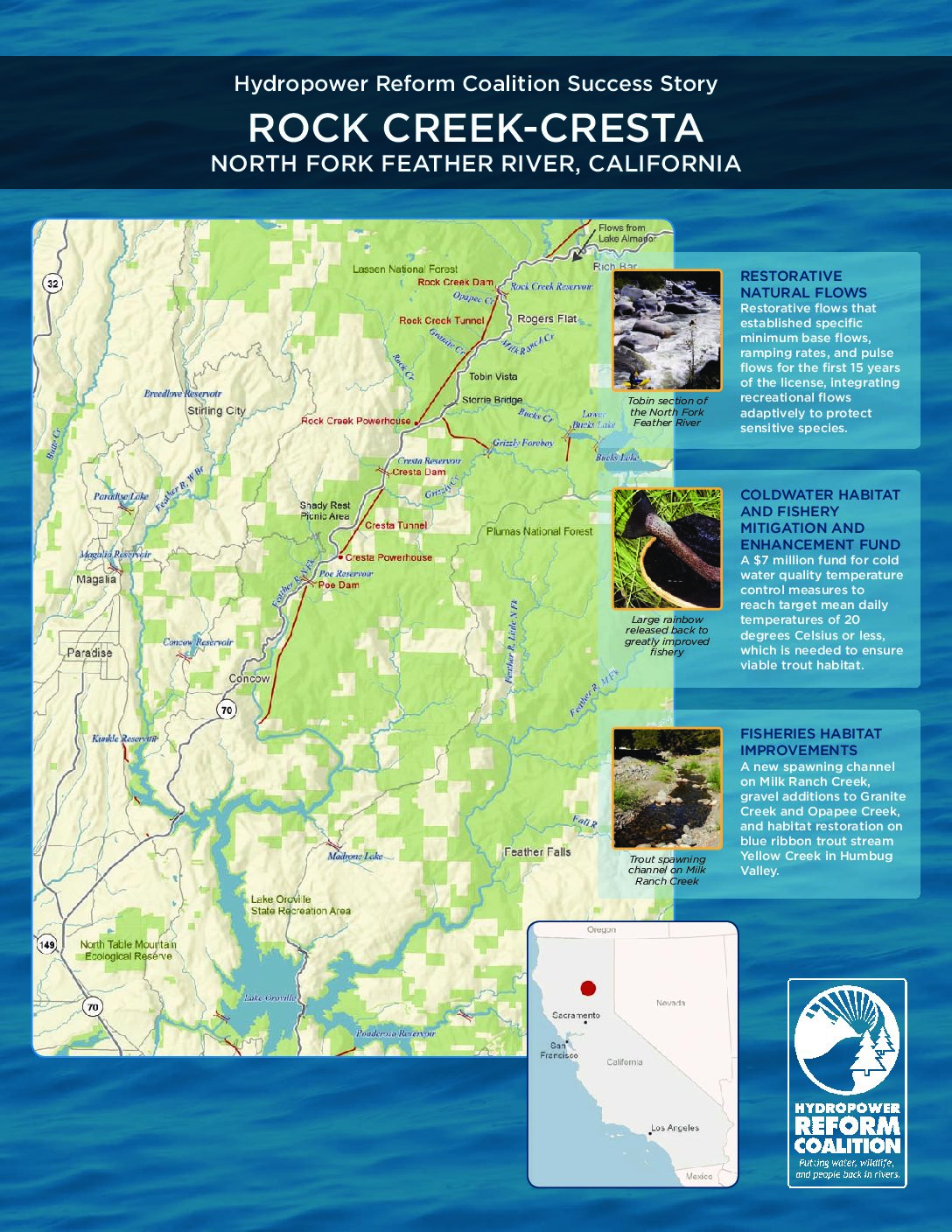The North Fork Feather originates near the southern boundary of Lassen Volcanic National Park and flows generally southward. The West Branch and North, Middle, and South Forks of the Feather River join underneath Lake Oroville to form the Feather River, a tributary of the Sacramento River. Before dams obstructed the way, the Feather River and its forks were well- known as major salmon rivers, documented as early as the 1840s.
The North Fork Feather is steep, dropping about 35 feet per mile. This gradient made the river a prime target for hydroelectric development. Several hydropower dams, owned and operated by Pacific Gas and Electric Company (PG&E), block and reroute the river and its tributaries, earning it the nickname “the Stairway of Power.”
This includes the Rock Creek and Cresta dams, with a 16-mile footprint on the North Fork Feather in the middle of the stairway. Licensed in 1947, completed in 1950, the Rock Creek-Cresta project consists of two developments, each with its own dam, reservoir and powerhouse. The Rock Creek Tunnel, upstream of Cresta, pipes water around 8.9 miles of the North Fork Feather; and the Cresta Tunnel routes water around an additional 4.4 miles of river. Combined, Rock Creek and Cresta powerhouses can generate up to 185 megawatts of power, under load-following “peaking” operations.
When the original license expired in 1982, PG&E had competitors for the profitable Rock Creek- Cresta project. A group of municipalities filed a competing application to operate the project, creating a legal conundrum that was not resolved until 1993.
After extensive disagreement about operation of the Rock Creek-Cresta under a future license, PG&E convened settlement negotiations in 1998. The Rock Creek-Cresta Project was still generally operating under the terms of its 50-year old license, and much needed to be updated. Minimum flows were flatlined and provided a fraction of the North Fork’s natural flow. Fisheries were decimated by high temperatures, low flows and damaged habitat in tributary refuges.
Stakeholders formed the Rock Creek-Cresta Relicensing Collaborative, which successfully reached agreement in 2000, leading to a new license in 2001. The new license establishes specific minimum flow ranges based on season, whether the year is a wet or dry one, and recreational flows. These flows are progressively adapted over a 15-year minimum period, with monitoring to ensure that resources are adequate, improving and healthy.
The Settlement Agreement established an Ecological Resources Committee made up of Settlement signatories. It meets regularly to review monitoring results, approve expenditures, make adjustments to resource plans, and give direction to management of the project. Coalition members serve on the ERC to ensure that North Fork Feather resources are cared for over the life of the license, until 2034.
Thousands of boaters have come to paddle the classic granite canyon of the North Fork Feather. The boating community enjoys summer recreational releases in the Rock Creek reach, but in the Cresta reach these special flows were suspended for several years because of a decline in the population of foothill yellow-legged frog, a sensitive species. While the cause of the decline was not clear, a compromise approach was worked out in 2009 as part of the ongoing adaptive management of the project by the Ecological Resources Committee. The solution changed the flow schedule for the Cresta reach to high flows in the spring and a more natural recession that lasts into the summer. This restoration of the shape of the natural hydrograph combines boating opportunities with flows that are both protective of frogs and beneficial to fish and aquatic insects.
While revised flows refresh the North Fork Feather and assist with water quality, the license established a mean daily temperature target of 20 degrees Celsius or less in the Rock Creek and Cresta reaches. To set aside funds for water quality measures, PG&E established a $5 million Coldwater Habitat and Fishery Mitigation and Enhancement Fund. If additional funds are necessary, PG&E may place another $2 million into the Fund.
To mitigate for damage to the North Fork Feather, PG&E agreed to rehabilitate 2,300 acres in the nearby Humbug Valley by protecting the meadowland from overgrazing. A blue ribbon trout stream, Yellow Creek, runs through the tract [pictured at right]. By the terms of the settlement, PG&E will rehabilitate Yellow Creek riparian lands and set aside nearly $500,000 to support ongoing enhancements to the land.


 HRC or member-contributed
HRC or member-contributed